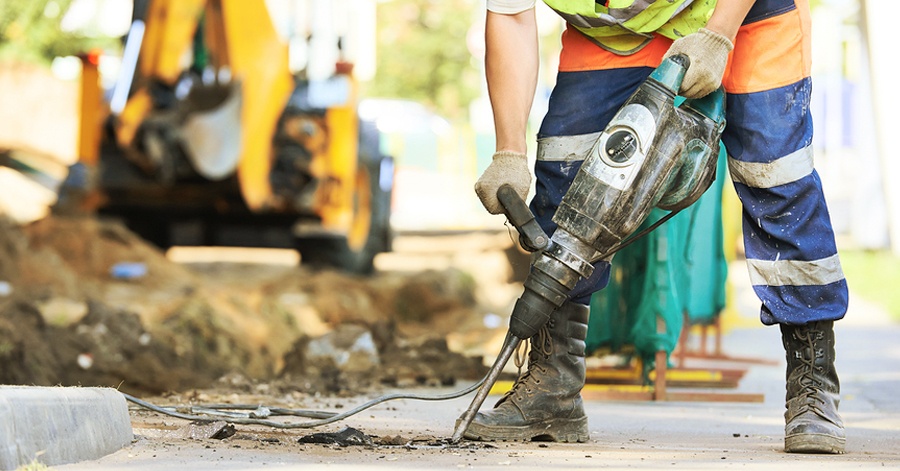
If you're a contractor on a job with power tools, a compressor, jack hammer, or other noisy power tools, you must have a construction noise mitigation plan posted on your site.
A construction noise mitigation plan is an intuitive strategy to reduce the overall impact of construction noise on its surroundings. Continue reading to learn more about the different components and ways to create a construction noise mitigation plan.
Construction Noise Mitigation Plan in the Design Phase
The impacts of noise can happen on virtually any project, including the construction of a highway. Although the magnitude of the impact of construction noise may not always be known during the early stages of the project, you can implement certain measures during the design phase to mitigate the anticipated impacts of noise at certain receptors.
Even so, design modifications and changes to the layout of the project are not always feasible or practical. In addition, the magnitude of the noise reduction gained from these techniques is typically hard to determine beforehand as well as during construction.
In the process of creating a construction noise mitigation plan during the design phase of any project, there are several opportunities for abatement that can be considered. Some of the most common abatement opportunities include:
- Haul Roads can be designated in areas where the impacts caused by traffic from trucks can be reduced.
- Existing Barriers can be used to mitigate sound. These barriers can be natural or artificial, such as noise walls, existing buildings, or other structures. In either case, existing barriers can be used to shield noise during particular operations.
- Detours are effective means of reducing the impacts of noise. It's important to understand that the additional traffic noise caused through the temporary rerouting of traffic during construction is considered to be a component of construction noise. It's vital to make efforts to minimize the impacts of this type of noise during the design phase.
- Storage Areas can be designated during the design and plan stages in areas away from sensitive receptors. When this isn't possible, the storage of earth, waste, and other various supplies may be positioned in a way that will act as a barrier of noise.
Sequence of Operation
The scheduling and sequencing of construction operations is just as vital as mitigating and addressing construction-related noise. With concurrent operations, you may be able to schedule the noisiest operations at the same time. This simple practice can help take advantage of the theory that the collective noise levels created may not be significantly more than the level of noise produced if each operation was performed individually.
You may also consider the early construction of noise barriers for your construction noise mitigation plan. If you are planning on using noise barriers for traffic noise abatement, those barriers may be installed during the early construction stages to minimize the noise impacts of the projects.
Alternate Construction Methods
In addition to standard construction noise mitigation plan techniques, there are alternate methods you can use. These methods may prove to be more cost-effective and practical in dealing with construction noise perceptions and noise impacts. A few of the most common examples associated with operations are listed below.
Pile Driving
Even when feasible noise reduction techniques are used, pile driving can produce exceptional noise levels in excess of limits that are acceptable. While shielding and damping methods may offer some reduction, these methods typically do not reduce the noise pollution to an acceptable level for sensitive receptors close to the site.
One highly effective alternative to using pile drivers is to utilize hydraulic or vibration insertion techniques. Another alternative is augured or drilled holes for cast-in-place piles. This option may produce noise levels lower than the traditional method of using a pile driver.
Compressors
Although the majority of compressors are powered by gasoline engines or diesel engines, most of them have innovative baffles, which are designed to help with the abatement of noise levels. However, you can take it one step farther with electric compressors. Electric compressors are much quieter than gasoline and diesel engine powered compressors.
Mitigating Noise with Equipment Controls
The most effective type of noise mitigation is to utilize source controls, which involve managing a source of noise before it rises to offensive levels. Construction noise is commonly generated by stationary equipment and mobile equipment. The noise levels produced are based on how the equipment is operated and equipment characteristics.
- Using less noisy equipment is one of the most effective ways to reduce the noise caused by individual equipment.
- Utilizing muffler systems can help to reduce the noise from internal combustion engines.
- Physically attached shields are excellent for reducing noise on stationary equipment.
- In instances where piles are drilled or driven through water, bubble curtains may be the excellent solution. This solution dampens shock waves and helps to reduce the effects on oceanic life.
- Dampeners are effective at minimizing noise caused by vibration.
- Sound aprons are typically designed from absorptive mats that are draped on the frames attached to the equipment. The material can be constructed from PVC layers, lead-filled fabric, or rubber. Sound aprons are most useful when the equipment only needs partial shielding or has to be regularly moved
- Enclosures can be used for stationary work. The walls could be lined up with sound absorptive material to further dampen the sound.
Contact Premier Safety Partners
If you are in charge of a construction site, you are required to have a construction noise mitigation plan posted. The experts at Premier Safety Partners are your health and safety professionals. We bring decades of experience helping construction site foreman and general contractors meet the various requirements of the respective municipality.
Contact Premier Safety Partners today to schedule a consultation.






